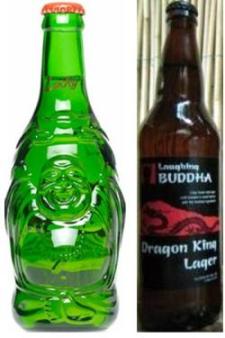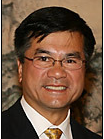Entries from February 1, 2009 - February 28, 2009
Save the Date for "Meet the Bloggers V" at INTA - Seattle on the Waterfront
The offices of Graham & Dunn, on Pier 70 in lovely Puget Sound:
Site of the upcoming “Meet the Bloggers V”!!
Doing my best to carry on the tradition started by my betters, STL is proud to host “Meet the Bloggers V” during this year’s International Trademark Association annual meeting — which not coincidentally is being held right here in Seattle.
Date: Monday, May 18
Time: 6-9 p.m.
Place: Graham & Dunn, Pier 70, 2801 Alaskan Way, Suite 300, Seattle
Eats/drinks: Traditional “Meet the Bloggers” munchies, beer, and wine
All trademark bloggers — and especially our beloved trademark blog readers — are welcome! RSVPs appreciated.
Mark your calendars!! Map and more intel to follow in May….
Seattle Craft Microbrewery Resolves Trademark Dispute by Changing Its Name
 Smouha Fabrics’ Lucky Buddha (left)
Smouha Fabrics’ Lucky Buddha (left)
and Laughing Buddha’s beer bottles
On Feb. 24, Seattle craft microbrewery Laughing Buddha Brewing Co. announced it has agreed to resolve a trademark dispute with Smouha Fabrics, owner of the Lucky Drink Company of Australia, by changing its name. Beginning April 1, the company will be known as the Trade Route Brewing Company.
Lucky Drink reportedly sent a cease-and-desist letter to Laughing Buddha in May 2008, alleging that Laughing Buddha’s name and trademark were confusingly similar to Lucky Drink’s LUCKY BUDDHA registered trademark and Buddha-bottle trade dress.
“We didn’t feel that we were infringing on their trademark,” Laughing Buddha’s co-owner Chris Castillo said in a written statement. “Smouha is a big corporation and we couldn’t afford to go through the litigation process.”
The soon-to-be-former Laughing Buddha began selling its Asian-influenced beer in the Seattle area in late 2007.
Thanks to Venkat Balasubramani of Seattle’s Spam Notes blog for the tip. He’ll be enjoying some sushi on me tomorrow.
Seattle's Gary Locke May Become New Commerce Secretary
 Seattle’s own Gary Locke may become Commerce secretary, the AP writes today.
Seattle’s own Gary Locke may become Commerce secretary, the AP writes today.
That would put Washington’s former two-term Democratic governor in charge of the Patent and Trademark Office. Or at least in charge of the folks who are in charge.
It would be nice to have an attorney serving in that capacity. Gov. Locke is a longtime member of the Washington State bar. After leaving public service in 2005, he has been partner at a Seattle-based firm focusing on China, energy, and government relations.
Seattle is already making quite an imprint on the Obama White House. In the last few weeks, Pres. Obama tapped King County Executive Ron Sims to be Deputy Secretary of Housing and Urban Development, and former Seattle Police Chief Norm Stamper to be drug czar.
Congratulations, Gov. Locke! Let’s hope for a speedy confirmation.
Photo credit: The Seattle Times
Western District Denies Rose Art's Motion for Award of Fees Following Dismissal

In 2007, PlastWood SRL sued competing toy maker Rose Art Industries, Inc., in the Western District, alleging that many of the structures depicted on the packaging of Rose Art’s Magnetix-branded magnetic construction sets could not be built and collapse under their own weight. PlastWood also brought a Lanham Act claim based on the allegation that Rose Art advertised its toys as being safe for ages “3 to 100,” when in fact they were not.
The Western District granted Rose Art’s motions to dismiss and for summary judgment, ultimately finding that PlastWood did not have any evidence that Rose Art’s advertisement was literally false and that “‘no reasonable jury could conclude that the structures on the Magnetix box [could not] be built as represented on the box.’” (STL posts on the court’s orders on Rose Art’s motions to dismiss and for summary judgment here and here.)
After winning dismissal, Rose Art moved for an award of attorney’s fees on the ground that the case was “exceptional” under 15 U.S.C. § 1117(a). Cases are “exceptional” for purposes of awarding fees to the defendant where plaintiff’s claims are either “groundless, unreasonable, vexatious, or pursued in bad faith.” Cairns v. Franklin Mint Co., 292 F.3d 1139, 1156 (9th Cir. 2002).
On Feb. 4, Western District Judge James Robart rejected Rose Art’s motion. It concluded: “The court dismissed the age label claim early on in the case because the court determined that enforcing PlastWood’s allegations regarding safety labeling as a Lanham Act claim would be incongruent with the safety labeling requirements set forth by the Consumer Product Safety Commission (‘CPSC’). The court did not find the claim ‘baseless’; rather, it found that the claim was better addressed by the CPSC. The court granted summary judgment on the remaining Lanham Act claim after discovery and a number of expert reports revealed that the alleged collapsing structures could be built supporting Rose Art’s claim that its advertisements were not literally false. The court likewise does not find that this claim was a ‘baseless’ claim but rather a well-litigated claim that ultimately favored Rose Art.”
Nor was the court convinced that PlastWood engaged in a ‘blatant effort to capitalize on publicity relating to the tragic death of a child attributable to Rose Art,’ as Rose Art alleged in its motion.
The case cite is PlastWood SRL v. Rose Art Industries, Inc., No. 07-458 (W.D. Wash. Feb. 4, 2009) (Robart, J.).
Federal Circuit Reverses $8 Million False Advertising Award in Baden v. Molten
On Feb. 13, the Federal Circuit reversed Western District Judge Marsha Pechman’s denial of judgment as a matter of law in Baden Sports, Inc. v. Kabushiki Kaisha Molten, 541 F.Supp.2d 1151 (W.D. Wash. 2008), relating to the jury’s award of $8,054,579 for false advertising under Section 43(a) of the Lanham Act. (STL post on the jury’s award here.) Baden claimed that competing basketball maker Molten falsely advertised that its basketballs were “innovative.”
The Federal Circuit’s reversal was based on its application of Dastar Corp. v. Twentieth Century Fox Film Corp., 539 U.S. 23 (2003), to this claim.
It found: “We agree with Molten that Dastar precludes Baden’s section 43(a) claim. The Supreme Court stated in Dastar that section 43(a) of the Lanham Act does not have boundless application as a remedy for unfair trade practices. Because of its inherently limited wording, section 43(a) can never be a federal codification of the overall law of unfair competition, but can only apply to certain unfair trade practices prohibited by its text. Section 43(a) of the Lanham Act does not create liability from Molten’s advertisements because those advertisements do not concern the ‘origin of goods,’ to which section 43(a)(1)(A) is directed, nor do they concern the ‘nature, characteristics, [or] qualities’ of the goods, which is what Ninth Circuit law has interpreted Section 43(a)(1)(B) to address.”
Applying Dastar to Baden’s claim under section 43(a)(1)(A), the court determined it needed to evaluate whether “Molten’s advertising refers to the ‘producer of the tangible goods,’ in which case a claim under section 43(a)(1)(A) would be proper, or whether it refers to ‘the author of’ the idea or concept behind Molten’s basketballs, in which case the claim would be foreclosed by Dastar.
“Looking at the case in this light, it is apparent that Dastar does not permit Baden to claim false advertising under section 43(a)(1)(A). Baden has not argued that someone other than Molten produces the infringing basketballs, and nothing in the record indicates that Molten is not in fact the producer of the balls. Thus, Baden’s claims are not actionable under section 43(a)(1)(A) because they do not ‘cause confusion … as to the origin’ of the basketballs.”
With regard to Baden’s section 43(a)(1)(B) claim, the court found: “[W]e must not examine whether Baden’s false advertising claims otherwise implicate the nature, characteristics, or qualities of the basketballs. Thus, we must determine whether Baden has alleged anything more than false designation of authorship. We conclude that Baden has not. No physical or functional attributes of the basketballs are implied by Molten’s advertisements. ‘Innovative’ only indicates, at most, that its manufacturer created something new, or that the product is new, irrespective of who created it. In essence, Baden’s arguments in this case amount to an attempt to avoid the holding in Dastar by framing a claim based on false attribution of authorship as a misrepresentation of the nature, characteristics, and qualities of the goods.”
The court concluded that Baden’s claims “do not go to the ‘nature, characteristics, [or] qualities’ of the goods, and are therefore not actionable under section 43(a)(1)(B). To find otherwise, i.e., to allow Baden to proceed with a false advertising claim that is fundamentally about the origin of an idea, is contrary to the Ninth Circuit’s interpretation of Dastar.”
For these reasons, the court vacated the jury’s damages award based on Baden’s false advertising claims.
Interestingly, the court added that if it had applied the law of another circuit, such as the First Circuit, the case “may well have [had] a different result.”
The case cite is Baden Sports, Inc. v. Molten USA, Inc., Nos. 2008-1216, 2008-1246 (Fed. Cir. Feb. 13, 2008).
